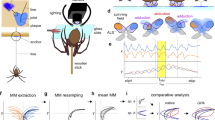Summary
Uloborid cribellar silk consists of torus-shaped puffs. In Miagrammopes animotus the width of these puffs is about 36% that of the cribellum of the spider and shows a 2.3-fold increase in surface area during development. The cribellar spigot number increase 5.7-fold during development, although, relative to spider mass, it decreases by 34%. Cribellum width is the best predictor of both cribellar silk puff width and length and is as good a predictor of puff surface area as is cribellum surface area. Relative to cribellum width, the length of the calamistrum comb responsible for drawing fibrils from the cribellum changes little during development. The attachment points of cribellar silk to a parallel frame thread become more widely spaced during development, although the number of puffs they delimit changes little.
Similar content being viewed by others
References
Comstock JH (1940) The spider book. Doubleday, Doran, New York
Friedrich V, Langer R (1969) Fine structure of cibrellate spider silk. Amer Zool 9:91–96
Langer RM, Eberhard WG (1969) Laboratory photography of spider silk. Amer Zool 9:97–102
Lubin YD (1986) Web building and prey capture in Uloboridae. In: Shear WA (ed) Spiders: webs, behavior, and evolution. Stanford University Press, Stanford, pp 132–171
Lubin YD, Eberhard WG, Montgomery GG (1978) Webs of Miagrammopes (Araneae: Uloboridae) in the Neotropics. Psyche 85:1–23
Opell BD (1979) Revision of the genera and tropical American species of the spider family Uloboridae. Bull Mus Comp Zool 148:433–549
Opell BD (1982a) Cribellum, calamistrum, and ventral comb ontogeny in the spider family Uloboridae. Bull Brit Arach Soc 5:338–343
Opell BD (1982b) Post-hatching development and web production of Hyptiotes cavatus (Hentz) (Araneae: Ulboridae). J Arach 10:185–191
Opell BD (1987) Changes in web-monitoring forces associated with web reduction in the spider family Uloboridae. Canadian J Zool 65:1028–1034
Peters HM (1983) Struktur und Herstellung von Fangfäden cribellater Spinnen. Verh Naturw Ver Hamburg (NF) 26:241–253
Peters HM (1984) The spinning apparatus of Uloboridae in relation to the structure and contruction of capture threads (Arachnida, Araneida). Zoomorphology 104:96–104
Peters HM (1986) Fine structure and function of capture threads. In: Nentwig N (ed) Ecophysiology of spiders. Springer, Berlin Heidelberg New York, pp 187–202
Author information
Authors and Affiliations
Rights and permissions
About this article
Cite this article
Opell, B.D. Functional associations between the cribellum spinning plate and capture threads of Miagrammopes animotus (Araneida, Uloboridae). Zoomorphology 108, 263–267 (1989). https://doi.org/10.1007/BF00312159
Received:
Issue Date:
DOI: https://doi.org/10.1007/BF00312159




